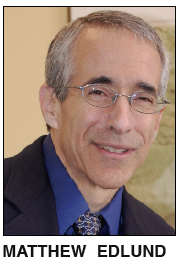MATTHEW EDLUND
Guest Writer
news@lbknews.com
Why sleep? is a question that has been asked for thousands of years. According to the magazine the Economist, a group of researchers at the University of Wisconsin, Madison, may now have a novel answer.
the University of Wisconsin, Madison, may now have a novel answer.
Sleep has long been thought to aid in the control of energy metabolism. Many have argued that eight hours of human sleep only “saves” two hundred calories of energy per night. That figure is now in dispute.
The energy saving has been calculated comparing human sleep with absolute rest. That may be inaccurate, according to sleep researcher Dr. Jerry Siegel of UCLA. A more relevant comparison would be with humans are meant to normal do – moving and walking. Compared with walking or normal human activity levels, sleep indeed saves a large amount of energy.
Yet energy preservation through sleep may occur prominently in a a site until recently less studied – the brain. So write Drs. Giulio Tononi and Chiara Cirelli, who have been studying sleep in both humans and fruit flies.
For a long time researchers considered it ridiculous to think that fruit flies “sleep.” Though their brains are very different from humans, flies do indeed have long periods of rest that mimic human sleep. There are also neuro-electrical discharges in their sleep similar to what happens in people.
Unlike humans, fruit flies are the best genetically studied species on the planet. With chromosomes which copy their DNA a thousand fold, the genetics of fruit flies is literally visible under the microscope. Since the work of Edward Hunt Morgan in the 1920’s, the genes of flies have now been extensively mapped for more than eighty years.
Fruit flies have visible chromosomes. They are easy to feed and multiply. Their lives are short. And they can be created in a huge number of mutant types where one can look at genetic changes one gene at a time.
One of the fruit fly mutants studied by Cirelli and Tononi is a very short sleeper. Rather than getting eight to twelve hours of sleep per day, these flies sleep only two to three hours. Rather like their short sleeping brethren human brethren, the short resting flies can at first try new tactics, and appear to learn.
What they can’t do is remember.
Recent clinical studies demonstrate that short human sleepers do not remember well. Both deep sleep and REM sleep, two very different but critical parts of sleep, are required for memory. Both states also appear necessary to come up with answers to complicated questions, as when we go and “sleep on” a problem.
What has recently been found discovered in people is something rather novel – activate a part of the brain during the day, and you will then watch the same part activate during deep sleep. Somehow during deep sleep, the traces laid down during the day, the changes in neuronal firing and proteins, are processed so that we learn and remember.
What Tononi thinks is going on is that deep sleep “pares down” the synapses and brain proteins that develop during the day. More activation of a brain region in the day leads to increased activation in the same place during deep sleep. Yet as the night goes on, the level of deep sleep markedly decreases.
Tononi believes the synapses are downsizing. Making new proteins and cell components, which happens when we learn, is expensive. It takes energy, materials and time. The more that’s left, the more you have to maintain. Deep sleep may be part of the process where memories are “downscaled” until some don’t exist at all.
This may explain why you can’t remember the color of the wall of the bank building you passed driving to work the previous morning. We don’t remember everything. We can’t. Sleep may allow us to specialize, to build up memories we need and discard those we do not. It may also economize on brain energy stores. Proteins, sugars, and fats have to be ingested and re-made. Cleaning up synapses and paring them during the night may save us a lot of fuel and materials. Sleep is the time when we resculpt the brain.
Others feel that Tononi is almost exactly wrong. For them, memories are “built up” during sleep, not downsized. But they don’t disagree that sleep is when the process of reinforcing memory and learning takes place.
Once again, food, sleep, and activity are linked at the cellular level. The more we think about a subject, the more that part of the brain is used. The more it is used, the more active it is in deep sleep. The better our sleep, the better our memories, and the smaller our waistlines.
Food, activity, and rest operate together in all the tissues of the body. Now there’s evidence linking energy, sleep, memory, and learning in the same process. It’s a process where the body rebuilds, resets, and resculpts itself, every day of the year. The body’s constant moves between creation and destruction literally create a new body over time. And a new brain configuration.
Rest rebuilds thought. Thinking is not just an active process, but a restful one as well. Getting a proper night’s rest is a good place to start is we want to think well

